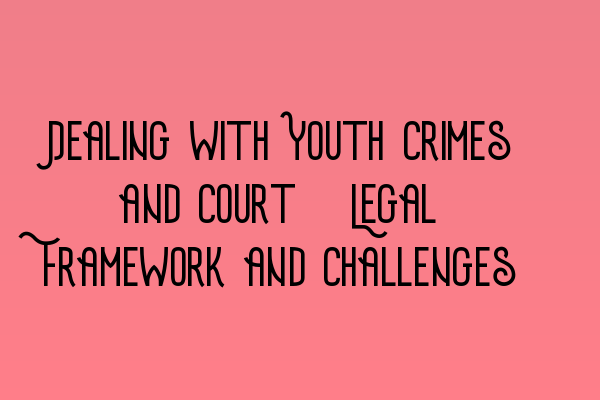Dealing with Youth Crimes and Court: Legal Framework and Challenges
As a parent, guardian, or legal practitioner, it is crucial to understand the legal framework surrounding youth crimes and court proceedings. The issues surrounding youth crimes can be complex and require careful navigation. In this article, we will explore the legal framework and challenges associated with dealing with youth crimes.
The Legal Framework
When it comes to youth crimes, the legal framework is established to protect the rights and best interests of young offenders. In the UK, the main legislation governing youth offenders is the Youth Justice and Criminal Evidence Act 1999. This act sets out the principles and procedures for dealing with youth crimes.
Under the Youth Justice and Criminal Evidence Act 1999, the youth court has jurisdiction over young offenders aged 10 to 17 years old. The court aims to rehabilitate rather than punish young offenders and focuses on the principles of welfare, proportionality, and intervention.
One of the key aspects of dealing with youth crimes is the involvement of Youth Offending Teams (YOTs). YOTs are multi-agency teams made up of professionals from various disciplines, such as social workers, probation officers, and police officers. They play a crucial role in assessing the needs of young offenders and creating individualized plans for their rehabilitation.
Challenges in Dealing with Youth Crimes
While the legal framework is designed to address the unique circumstances of youth crimes, there are several challenges that arise in practice.
1. Maturity and Responsibility
One of the challenges in dealing with youth crimes is determining the level of maturity and responsibility of young offenders. The age range between 10 and 17 years old encompasses a wide developmental spectrum. It can be difficult to determine whether a young offender has the capacity to understand the consequences of their actions.
Addressing this challenge requires the expertise of professionals who can assess the cognitive and emotional development of young offenders. Their input is essential in determining the appropriate interventions and support needed to rehabilitate young offenders.
2. Rehabilitation vs. Punishment
Another challenge in dealing with youth crimes is striking the right balance between rehabilitation and punishment. While the youth justice system focuses on rehabilitation, there is still a need for accountability and consequences for the actions of young offenders.
It is essential to ensure that the punishment imposed on young offenders does not hinder their rehabilitation and reintegration into society. Balancing the need for accountability with the aim of rehabilitation is a delicate undertaking.
3. Prevention and Early Intervention
Prevention and early intervention are key components of effectively dealing with youth crimes. Identifying the risk factors and early signs of potential criminal behavior can help divert young individuals from the path of crime.
By implementing targeted prevention programs and providing support at an early stage, the justice system can intervene before a young person’s involvement in criminal activities escalates. This proactive approach aims to break the cycle of offending and improve the outcomes for young offenders.
Conclusion
Navigating the legal framework surrounding youth crimes requires a comprehensive understanding of the legislation and the challenges involved. It is crucial to approach these cases with sensitivity and a focus on rehabilitation rather than punishment.
By addressing the challenges presented by maturity and responsibility, striking the right balance between rehabilitation and punishment, and implementing prevention and early intervention measures, we can improve the outcomes for young offenders.
For more information on related legal topics, please check out these articles:
- Legal Representation for Delaware LLCs in the UK: Expert Advice
- Ensuring Ethical Business Practices: Delaware’s Code of Conduct
- Legal Challenges for UK Businesses in the U.S.: Strategies for Overcoming Hurdles
- UK Criminal Law: An In-Depth Analysis of the British Legal System
- Legal Challenges for UK Businesses in the U.S.: Strategies for Overcoming Hurdles
